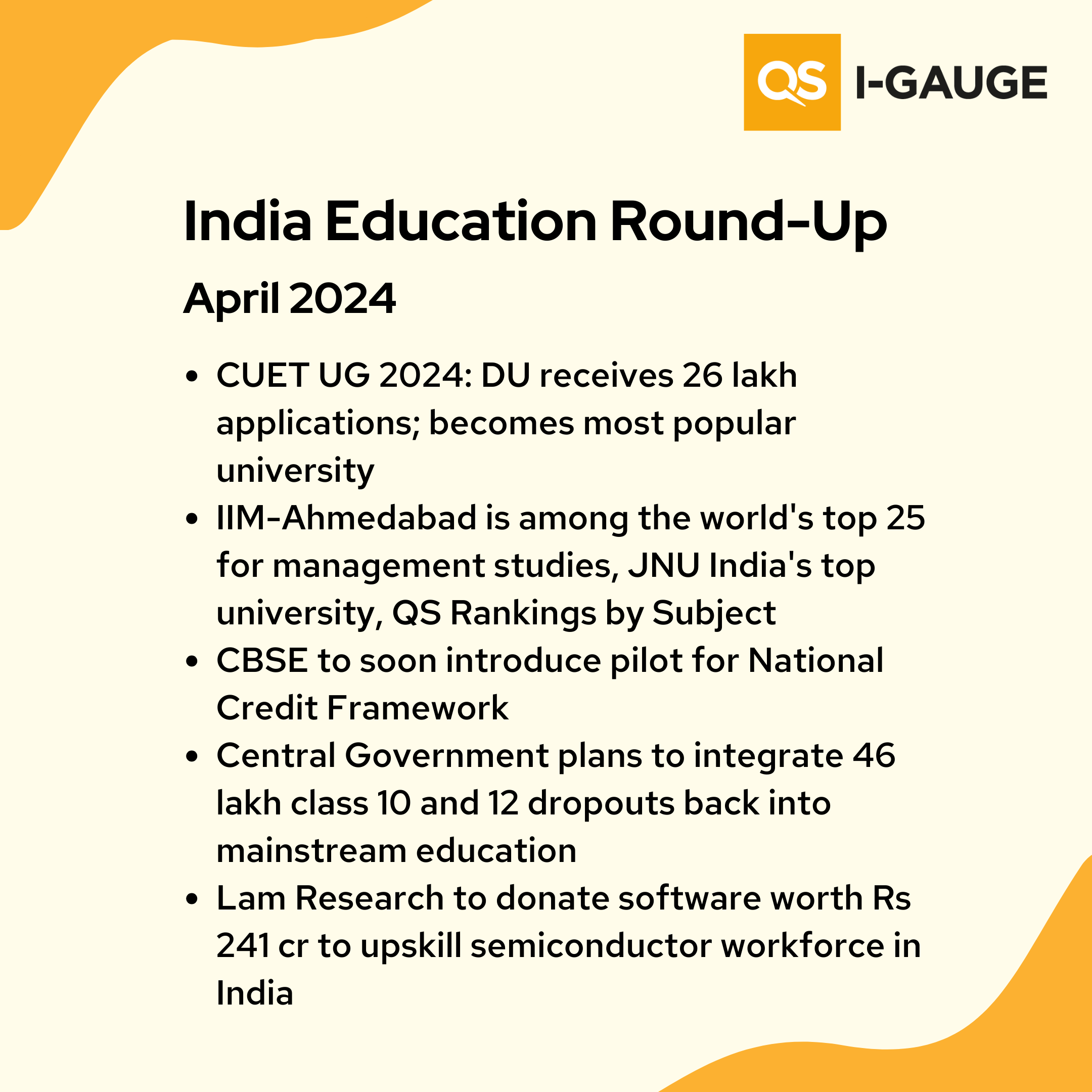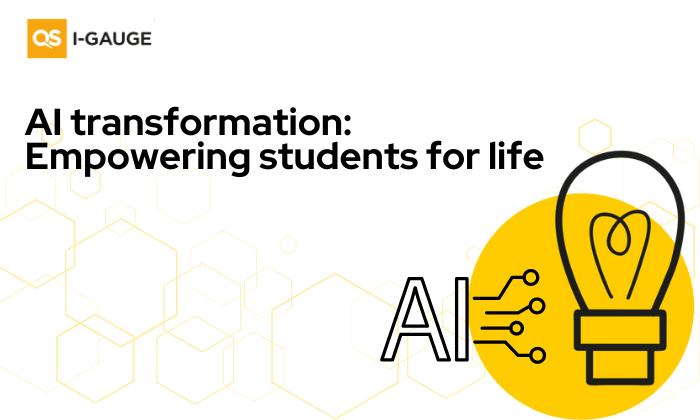
India Education Round-Up | April 2024 | Central Government plans to integrate 46 lakh class 10 and 12 dropouts back into mainstream education
Serving as a primer for news articles in print/digital media, this write-up aims to share recent notable events in Indian education, inspiring educators and stakeholders to adopt best practices. It is crafted to be a valuable source of information for individuals keen on staying updated about the latest trends, events, and innovations in Indian education. By keeping abreast of these developments and incorporating best practices, we can collectively contribute to the vision of providing high-quality education at an affordable cost to everyone in India and globally.
CUET UG 2024: DU receives 26 lakh applications; becomes most popular university
New Delhi: In a significant development for the Indian education system, a study has revealed the number of applications received by universities through the highly anticipated Common University Entrance Test (CUET) UG 2024 exam. Topping the list is Delhi University (DU), which has received a staggering 26 lakh applications from students across the country. DU, known for its diverse range of UG courses, offers around 80,000 seats for admission. Last year, it received a total of 28.3 lakh applications; however, the numbers are expected to increase as we approach the counselling period. A total of 261 universities are participating in the admission process through CUET UG 2024 for admission to their various UG courses. The National Testing Agency (NTA), the conducting body for the CUET UG 2024 Exam, has received 13.4 lakh applications in total, as per official records.
The high demand for quality education in India is evident from the number of applications received by various universities. While Delhi University (DU) has emerged as the most popular choice among students, with 26 lakh applications, other universities have also seen a significant number of applications. Benaras Hindu University (BHU) is the second most popular, with 8.4 lakh applications, followed by Babasaheb Bhimrao Ambedkar University (BBAU), Lucknow, with 5.1 lakh applications. This surge in applications is a testament to the growing aspirations of Indian students and the need for more institutions to cater to their educational needs.
IIM-Ahmedabad among world's top 25 for management studies, JNU India's top university: QS Rankings by Subject
According to the QS World University Rankings by Subject, announced recently, IIM-Ahmedabad is among the top 25 institutions globally for business and management studies, while IIM-Bangalore and IIM-Calcutta are among the top 50. Jawaharlal Nehru University is the highest-ranked university in India, ranking 20th globally for development studies. The Saveetha Institute of Medical and Technical Sciences in Chennai is in the 24th position globally for dentistry studies.
In this year's QS World University Rankings by Subject, India has demonstrated significant progress, with a 20 per cent improvement in the Citations per Paper indicator, reflecting a strong research capability. According to QS, India stands as one of the world's most rapidly expanding research centres. From 2017 to 2022, its research output surged by an impressive 54 per cent, based on data from Scopus/Elsevier, QS' bibliometric and research affiliate. This increase is not only more than double the global average but also significantly exceeds the output of its more traditionally recognised Western peers.
CBSE to soon introduce pilot for National Credit Framework for classes 6, 9 and 11
The Central Board of Secondary Education (CBSE) plans to introduce a trial run of the National Credit Framework (NCrF) for grades 6, 9, and 11 starting from the academic session of 2024-25, extending invitations to its affiliated schools for participation.
Last year, the Government initiated the National Credit Framework as a component of implementing the National Education Policy (NEP) of 2020. It aims to facilitate the smooth merging of school, higher, and vocational education, enabling students to accumulate credits from pre-primary education up to PhD level. Following this, CBSE formulated draft guidelines for the implementation of the framework.
"The CBSE developed and circulated draft NCrF implementation guidelines, discussed them in multiple workshops, and received approval from the Union Ministry of Education. To further test, refine, and assess their effectiveness in real-world contexts, a pilot implementation of these guidelines has been planned in CBSE-affiliated schools in classes 6, 9, and 11, with effect from session 2024-2025," the board said in a letter to school principals.
Central Government plans to integrate 46 lakh class 10 and 12 dropouts back into mainstream education
According to Education Ministry sources, mainstreaming the 46 lakh dropouts at the secondary and senior secondary levels remains a top priority for the Centre in the first 100 days of the next government and is also part of the five-year agenda for school education. One of the strategies is to provide an opportunity for students who do not qualify for classes 11 and above to take exams for the same class, allowing them to attend as regular candidates. The Centre also intends to utilise the APAAR (Automated Permanent Academic Account Registry) identification system to monitor individuals who are at risk of failing, which often results in dropouts.
According to Education Ministry sources, various options are under consideration to ensure the education continuity of approximately 34 lakh students failing in class 10 and 12 lakh in class 12 nationwide. While elementary education enrollment is nearly 100% according to the Gross Enrolment Ratio (GER), there are challenges at the secondary and higher secondary levels. The ministry is also considering the Andhra Pradesh government’s decision from last year, which permitted schools to readmit students who failed in classes X and XII in the preceding two years, enabling them to attend regular classes for the same course.
The National Education Policy 2020 sets the target of achieving a 100% GER at the secondary and senior secondary levels by 2030. Government data shows a significant reduction in the dropout rate at class X over the past four years, decreasing from 28.4% in 2018-19 to 20.6% in 2021-22.
Lam Research to donate software worth Rs 241 cr to upskill semiconductor workforce in India
Lam Research Corp has announced the signing of a tripartite memorandum of understanding (MoU) with the India Semiconductor Mission (ISM) and the Indian Institute of Science (IISc) to broaden the deployment of ‘Semiverse Solutions’ to develop India’s semiconductor manufacturing workforce.
Lam Research said in a statement that it is donating nearly $29 million (Rs 241 crore) in software licenses over the next two years to enable 2,800 students, while ISM is supporting the establishment of infrastructure and operational costs. IISc will “Train the Trainers” at the selected universities, while Lam will deploy a dedicated team of employees to support the expansion across the country.
Disclaimer
The views and opinions expressed in this blog do not necessarily represent those of QS-ERA India Private Limited and/or its employees, partners, shareholders, or other stakeholders.
Sources
https://collegedunia.com/news/cuet-ug-2024-du-receives-26-lakh-applications-alertid-123024






Leave Your Comments